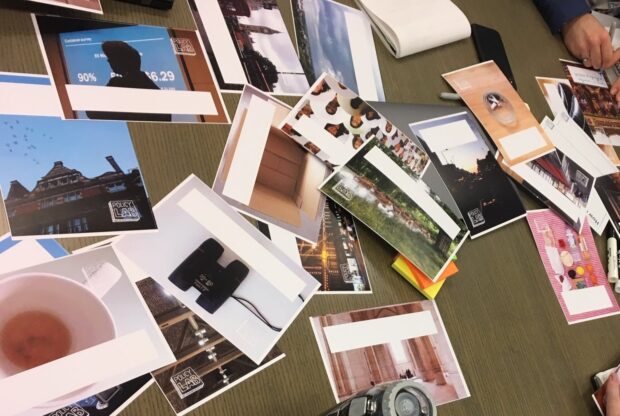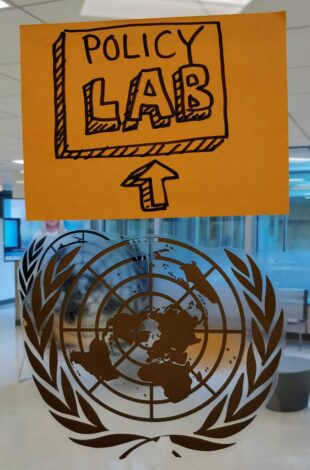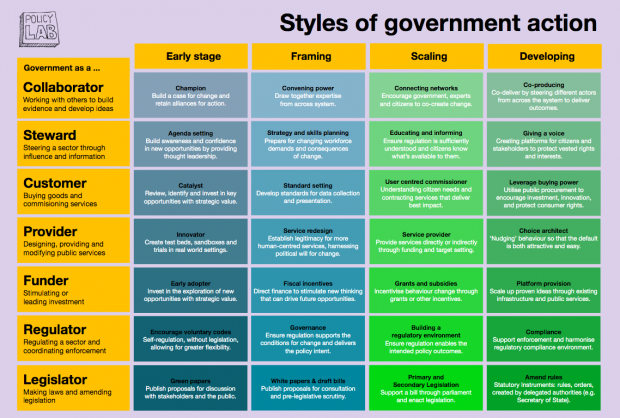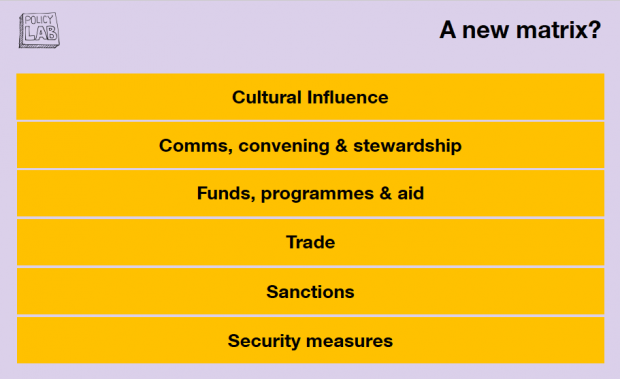This year Policy Lab has been working on a project with the United Nations (UN) to bring the voices of people in a geographically distributed organisation into early stage policy design and development. We wanted to share some of what we have learnt - and to mark the Foreign and Commonwealth Office’s (FCO) Policy Week (13-17 May 2019). We'd like to thank FCO staff for taking part in our training yesterday.
At the Lab, our methods and approaches have been shaped over five years by working mostly inside the UK public sector - whilst we make much of what we do public and available outside the UK - the application to international or multilateral organisations is relatively new to us. Through our work with the UN we are beginning to see where open policy making approaches can be used in organisations that are devolved across national boundaries and in foreign policy contexts. We are also seeing limits.

Since about 2014 open policy making, as defined by the UK government, has involved “broadening the range of people and quality of engagement” in policy development, including by working collaboratively. Many of the approaches we use in Policy Lab follow the principles of open policy making. For example, there is a major emphasis in our work on methods to engender multi-stakeholder contributions to policy development. Usually this happens face-to-face, through workshops or in the ethnographic research that we often undertake at the start of a policy project. One obvious change for us working in foreign policy is that we are having to consider how tools that are designed to work in person can be used in more diffuse contexts.
With the UN we are learning what to transfer and where to adapt - here we give four practical examples.

Ethnography
Most substantive Policy Lab projects begin with film ethnography - a research practice involving the observation and filming of groups or individuals in familiar contexts, like their homes or places of work. With our policy partners and the consent of our research participants, we use these films to bring the voice of people affected into policy development and as material to inform how we design policies. In international policy making - where the distance between decision and action is arguably even further than in national contexts - there is all the more reason to create living records of how and where policies have an impact. This might include internal ethnography, with staff in different postings or country offices.
Here is a link to a blog with an example of Policy Lab ethnography with the Department of Work and Pensions into Jobcentre Plus services.
Convening
In the Lab we place huge importance on convening different groups of people around a policy challenge. This can take place in one off workshops or as a routine part of our policy projects - for example to gain different perspectives on how to frame a policy challenge at the start of a project or by sharing findings, recommendations and designs as widely as we can when our work concludes.
Convening diverse interest groups is a well established aspect of foreign policy - but our observation is that the formality of these environments and the nature of the issues at stake can stymie meaningful dialogue.
We have learnt that where a more open format is deployed, for example in multi-stakeholder idea generation, space is created for different voices to be heard. But the collaborative, relatively informal convening style we use in the Lab can be counter-cultural. Therefore participants need to be adequately prepared for the different rhythm and demands of a Policy Lab workshop, especially where people representing multiple languages and cultures are involved.
Visualisation
Another core working practice for the Policy Lab team is to make and visualise things as we work. This can involve using visual tools or templates used in workshop settings, as well as visualisations of systems or parts of systems to aid understanding - for example a roadmap for the policy development journey in a given context. We also make things as a result of our projects, including guidelines, strategies and process maps.
Working visually helps to build consensus or reveal where it is absent, because it requires people to assess a common representation rather than referring to the mental models that we all hold. In a foreign or multilateral policy context where many different interests collide, creating shared understanding is hugely important. We have seen many opportunities for visual strategies in our recent work over the years, such as clear representation of the policy development and approval process where many actors are involved.
At the start of this year, we helped the Department for Transport to develop the UK’s first Maritime Autonomy Strategy which involved visual gaming of alternative futures. Here is a blog on how we did this.
Styles of Action
For the past two years Policy Lab has been using a new tool to help domestic policy makers assess the spectrum of actions they can take to deliver a policy goal, we call this “Styles of Action”. The actions we identify range from soft interventions such as “stewardship” through to hard levers like “regulation” and “legislation”. There are seven actions in our current framework and we intend them as guidelines or prompts for decision-making.
Like many of our tools, the Styles of Action were not devised as a “finished product”, instead we encourage adoption and adaption in local contexts. Our current view is that a similar framework could help foreign policy decision-making, but that the domestic actions do not cover the full span of foreign policy levers, such as “sanctions”.

You can read more about the Styles of Action in the blog linked here.
Here is a link to some cards which make the framework a little easier to use.
Through our recent training work at the FCO and with UN we have begun to reframe some of our approaches for a new environment, including the “Styles of Action”.

In common with many of our projects, understanding how we can support people working in foreign policy relies on the insight and expertise of our project partners.
We’d love to hear from anyone working on open (foreign) policy development about our early attempt to define foreign policy styles of action. Or about any of the other Lab tools, which you can find out more about in our Open Policy Toolkit.
Leave a comment